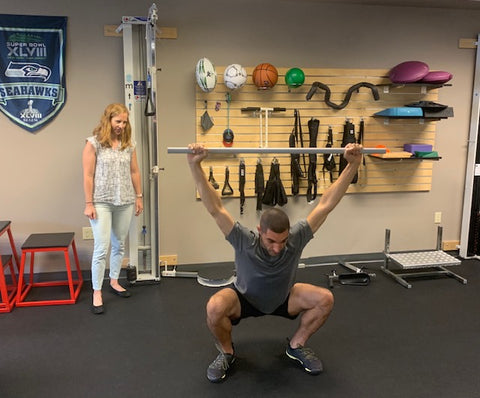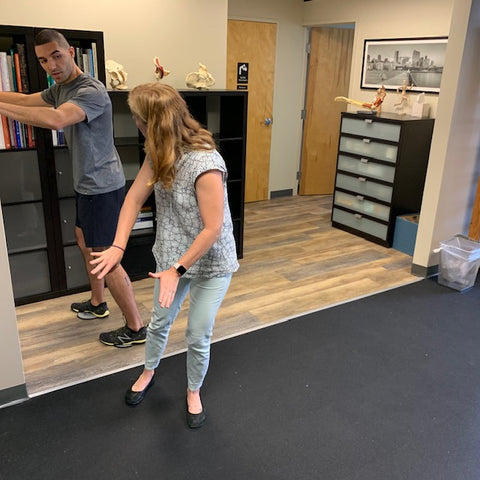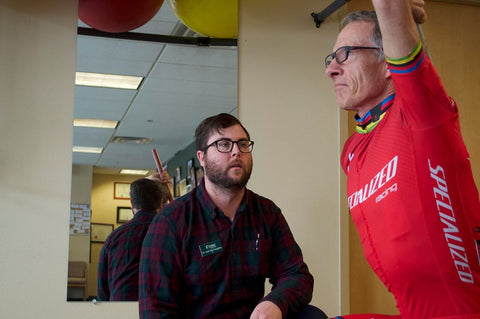As stated in the article below...
“The benefit of training movement patterns in the off-season is the opportunity for a skier to develop mastery of a specific movement. This is when habitual movement patterns are best retrained, not while on snow.”
Dryland Ski Training: Part 1 – Are You in a Place Where You Don’t Know, What You Don’t Know?
Want to ski like Steve and Phil Mahre? Off season drills that address your less-than-efficient movement patterns go a long way. Taking one of their excellent clinics helps as well.
There are so many online tools out there for skiing performance - it seems every other person has an idea about what is right. Without having someone who can really assess HOW you move, you will only continue to build compensation - fitness alone is only part of the picture. – Dr. Anne Healzer Garske
This article is not about killer workouts. It is about assessing where you are, and what you need to work on to achieve your skiing goals. This is about information that helps you plot your course. Or as
United States Ski Team High Performance Director,
Troy Taylor said, ‘You need to know where you are, where you want to go, and develop a plan to get there”.
Functional Movement Analysis for Skiers
Enter FMS, or
Functional Movement Analysis. FMS has been a standard in the Military and athletic world for some time. To dig deeper we went to the source,
Ellen K Donald PT PhD. With a PhD in Educational Measurement and Research, she is a leader in her field. According to Dr. Donald, “All of the movements found in the FMS are common movements that a skilled physical therapist would assess if doing a comprehensive assessment of an active person. This collection of movements certainly gives you a good overview of the nature of a person's movement, and where they may lack control, range of motion, or balance.”
Essentially, FMS is a standardized functional movement protocol. Its accuracy and relevance is highly dependent on the therapist administering it. Its value is in discovering where your limitations are. According to Dr. Donald, “…if you move better, have better core control, are able to stabilize while moving dynamically, you will be less likely to experience injury.” To that list, I’ll add that if you are stabilized when you move dynamically, you can exert more power, with less physical effort. An FMS test is a diagnostic tool that can help you get there.
I know that you are not out to win a national title. In my experience of teaching alpine skiing full-time, the number one limiter of guests’ ability to enjoy their vacation is often manifested in a lack of range of motion. They simply do not have the range of motion to use their equipment the way that it was designed. They fight for every turn, and are gassed.
Perhaps USST’s Troy Taylor said it best, “Skiing is a complex activity, even at the recreational level, technical skill needs to be met with physical and mental competency in order to mitigate the likelihood of injuries and maximize enjoyment on the slopes.”
We’re talking about stoke.
How to Utilize FMS for Skiing
While FMS is a great tool, interpreting the results and having an accurate action plan for skiing will depend on the skill of the practitioner. It boils down to your practitioner having a deep understanding of skiing mechanics. If your PT is not certified as an instructor and / or coach, they are probably not your best source of the truth.
Dr. Anne Healzer Garske administers an FMS evaluation
Fortunately, a few of these individuals exist. In the recreational ski world,
Dr. Anne Healzer Garske, in the Seattle, Washington area, may be the best resource. Dr. Healzer is not only a doctorate level PT, she is also a PSIA Level III instructor.
Dr. Healzer’s journey with the melding of skiing and PT started when she struggled to improve her skiing. She selected exercises that mimic the movements to train while off the hill, for greater efficiency on the hill. Dr. Healzer states, “The benefit of training movement patterns in the off-season is the opportunity for a skier to develop mastery of a specific movement. This is when habitual movement patterns are best retrained, not while on snow.”
If you are not vibing with a trip to Washington State, Dr. Healzer can work with skiers remotely. The first step is to have an FMS conducted locally. Costs can range from free at local health fairs, to several hundred dollars for an office visit. Get your hands on those written results, and contact information for the administering PT. With those results, and ideally a video of your skiing, Dr. Healzer can help you identify areas that need attention.
If you are after a ski vacation, Washington State may be the best kept secret in the ski world. Spend some time with Dr. Healzer, road trip up to
Mt Baker,
Steven’s Pass Ski Area,
Crystal Mountain and the
Mahre brother’s lair,
White Pass.
In my case, Dr. Healzer advised that I had all of the strength that I ever needed. My limiter was range of motion. While I adore weight training, it was not what I needed. So rather than doing what I like, I did what needed to be done. The results in my skiing efficiencies were profound. Sometimes you need to suck it up, and be comfortable with being uncomfortable, to move forward on your path of mastery.
Do short radius turns and bumps just kill you? It may not be your skis. Or your boots. It may be that you simply do not have the lower torso range of motion to execute. FMS, swivel plates, and a prescribed range of motion drills may do more for you than any new piece of equipment.
It should be noted that a person’s aggregate FMS score is also not a reflection of ability in their chosen domain. According to
Dr. Josh MacNaughton, specialists who compete at the razor’s edge, like world-class cyclists, often score relatively low on FMS. Take a look at the most efficient cyclists’ builds: svelte cores and upper bodies, coupled with ripped legs. Core strength is lacking. It doesn’t mean that those athletes are not fit. It just means that they are ideally honed for their chosen endeavor.
World Mountain Bike Champion undergoes an integrated bike fit / FMS evaluation at Tomsic PT in Durango, Colorado. FMS can be used for virtually any athletic domain. Your results will depend on the skill of the practitioner administering it.
Is it worth it? Many fitness and nutrition articles posted on-line are generally worth about what they cost. Best case scenario: you will discover a movement or two that is challenging, and it may lead to better performance. Worst case scenario: you will adopt a movement or exercise that adds to imbalances that you already have, thereby making a less than ideal situation worst. Without FMS assessment, you are really in a place where you don’t know what you don’t know.
The assessment is also the easy part. The hard part is executing the action plan. Like me, you may adore weight training. And it may not be what you need on your path to mastery. It might be that what you need to do is something that you absolutely suck at, and don’t enjoy. Now is when you test if your commitment is fleeting, or forever.
I’m fond of a quote by legendary strength coach Louie Simmons, "When you attempt to build capacity on dysfunction, you are actually deepening the attractor state of your compensation. Thus, you are building compensation, not capacity.” As we age, and it doesn’t matter if we are 17 or 70, we inevitably impact our bodies with wear and tear. Regardless of athletic domain, if those impacts and limitations are not addressed, we tend to build compensation to work around them, and not real capacity.
This is first in a series of articles by Point 6 Ambassador and PSIA instructor Marty Grabijas, and PSIA Instructor and Dr. Anne Healzer Garske. Watch this page for future articles that will outline specific drills to tackle the most commonly seen limiters to skiing performance.
Marty Grabijas is a PSIA Instructor who works at ski areas that provide exceptional guest experiences. His day job, which he is retired from, was as a product developer in the outdoor industry. Off season he is an examiner for whitewater kayaking, rides bikes, and chases high-alpine objectives in Colorado’s Weminuchi Wilderness Area.
Dr. Anne Healzer Garske specializes in orthopaedic manual therapy and is experienced in treating a wide range of musculoskeletal injuries including post surgical cases, complex spine injuries, and injuries related to sport activities. She treats master and professional level athletes 





 ).
).